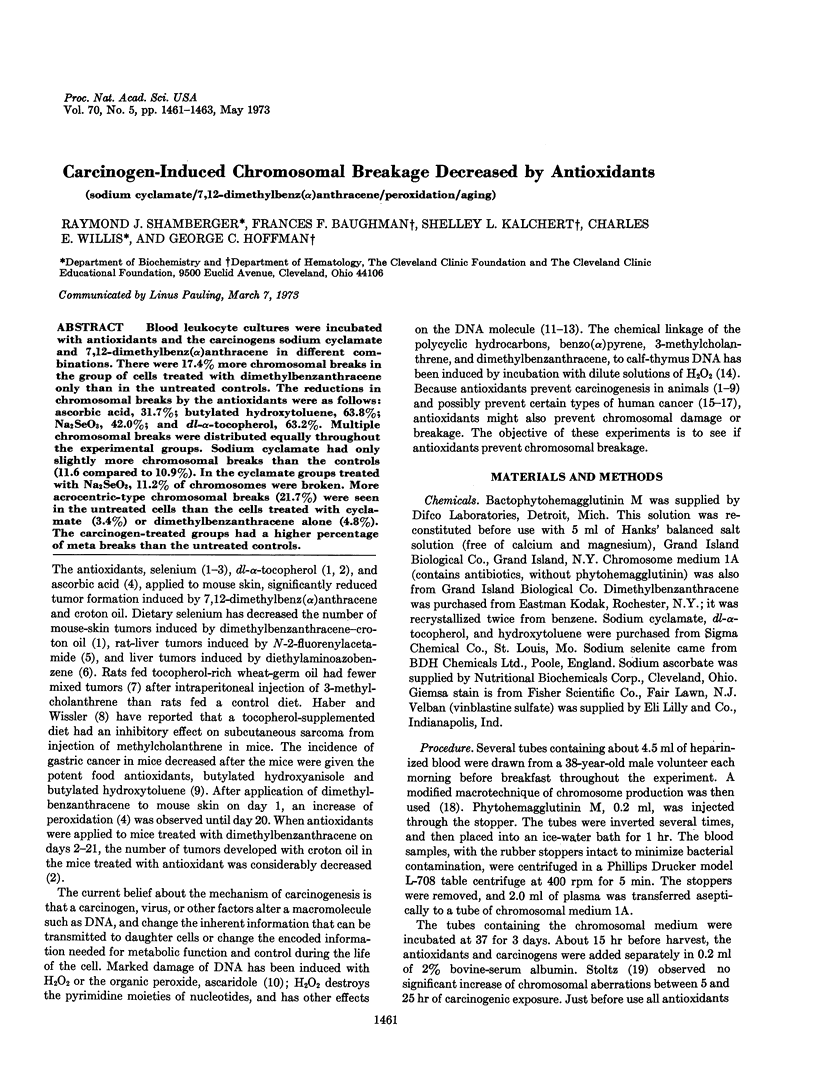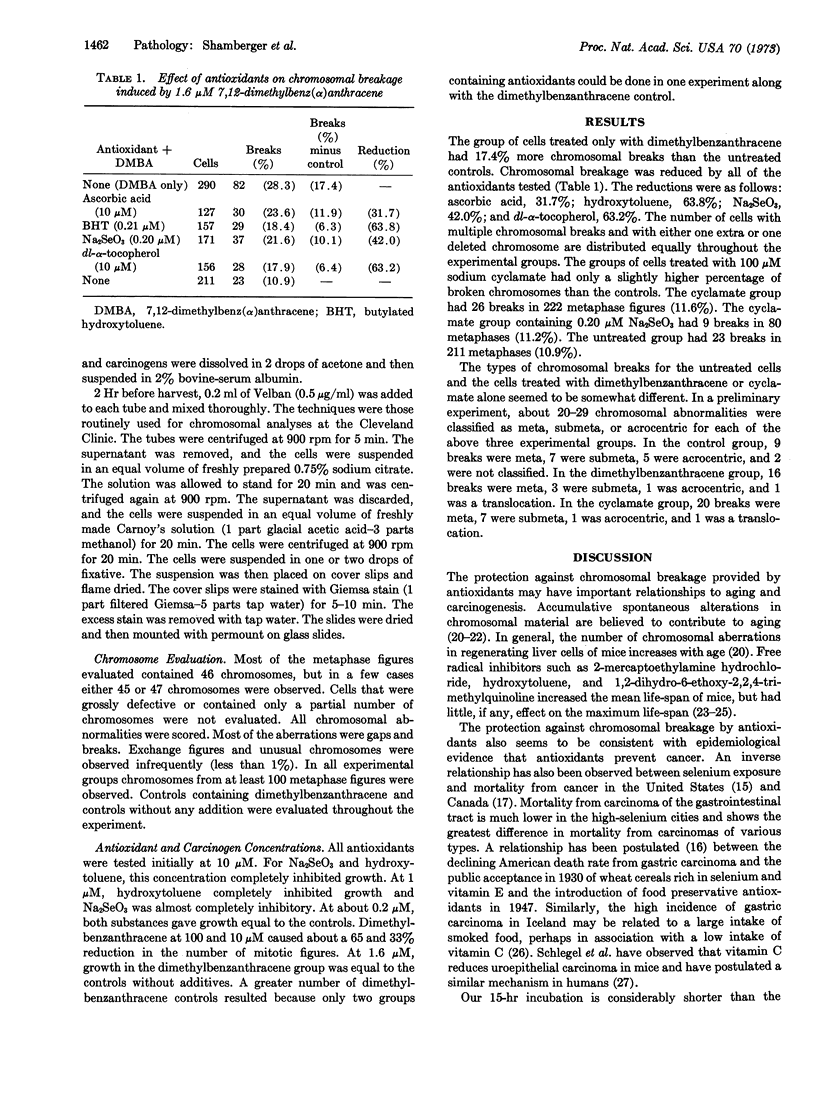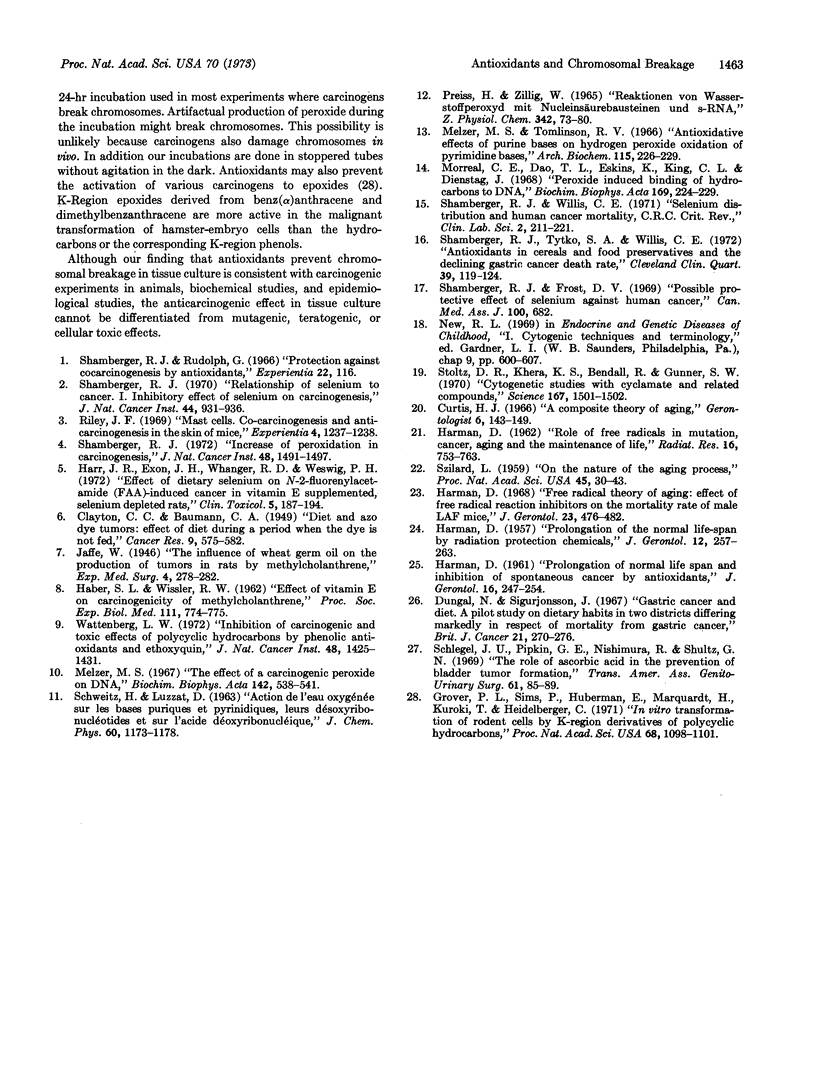Abstract
Blood leukocyte cultures were incubated with antioxidants and the carcinogens sodium cyclamate and 7,12-dimethylbenz(α)anthracene in different combinations. There were 17.4% more chromosomal breaks in the group of cells treated with dimethylbenzanthracene only than in the untreated controls. The reductions in chromosomal breaks by the antioxidants were as follows: ascorbic acid, 31.7%; butylated hydroxytoluene, 63.8%; Na2SeO3, 42.0%; and dl-α-tocopherol, 63.2%. Multiple chromosomal breaks were distributed equally throughout the experimental groups. Sodium cyclamate had only slightly more chromosomal breaks than the controls (11.6 compared to 10.9%). In the cyclamate groups treated with Na2SeO3, 11.2% of chromosomes were broken. More acrocentric-type chromosomal breaks (21.7%) were seen in the untreated cells than the cells treated with cyclamate (3.4%) or dimethylbenzanthracene alone (4.8%). The carcinogen-treated groups had a higher percentage of meta breaks than the untreated controls.
Keywords: sodium cyclamate; 7,12-dimethylbenz(α)anthracene; peroxidation; aging
Full text
PDF


Selected References
These references are in PubMed. This may not be the complete list of references from this article.
- Curtis H. J. A composite theory of aging. Gerontologist. 1966 Sep;6(3):143–149. doi: 10.1093/geront/6.3_part_1.143. [DOI] [PubMed] [Google Scholar]
- Dungal N., Sigurjonsson J. Gastric cancer and diet. A pilot study on dietary habits in two districts differing markedly in respect of mortality from gastric cancer. Br J Cancer. 1967 Jun;21(2):270–276. doi: 10.1038/bjc.1967.29. [DOI] [PMC free article] [PubMed] [Google Scholar]
- Grover P. L., Sims P., Huberman E., Marquardt H., Kuroki T., Heidelberger C. In vitro transformation of rodent cells by K-region derivatives of polycyclic hydrocarbons. Proc Natl Acad Sci U S A. 1971 Jun;68(6):1098–1101. doi: 10.1073/pnas.68.6.1098. [DOI] [PMC free article] [PubMed] [Google Scholar]
- HARMAN D. Prolongation of the normal life span by radiation protection chemicals. J Gerontol. 1957 Jul;12(3):257–263. doi: 10.1093/geronj/12.3.257. [DOI] [PubMed] [Google Scholar]
- HARMAN D. Prolongation of the normal lifespan and inhibition of spontaneous cancer by antioxidants. J Gerontol. 1961 Jul;16:247–254. doi: 10.1093/geronj/16.3.247. [DOI] [PubMed] [Google Scholar]
- HARMAN D. Role of free radicals in mutation, cancer, aging, and the maintenance of life. Radiat Res. 1962 May;16:753–763. [PubMed] [Google Scholar]
- Harman D. Free radical theory of aging: effect of free radical reaction inhibitors on the mortality rate of male LAF mice. J Gerontol. 1968 Oct;23(4):476–482. doi: 10.1093/geronj/23.4.476. [DOI] [PubMed] [Google Scholar]
- Harr J. R., Exon J. H., Whanger P. D., Weswig P. H. Effect of dietary selenium on N-2 fluorenyl-acetamide (FAA)-induced cancer in vitamin E supplemented, selenium depleted rats. Clin Toxicol. 1972;5(2):187–194. doi: 10.3109/15563657208990998. [DOI] [PubMed] [Google Scholar]
- Melzer M. S. The effect of a carcinogenic peroxide on DNA. Biochim Biophys Acta. 1967 Jul 18;142(2):538–541. doi: 10.1016/0005-2787(67)90635-1. [DOI] [PubMed] [Google Scholar]
- Melzer M. S., Tomlinson R. V. Antioxidative effects of purine bases on hydrogen peroxide oxidation of pyrimidine bases. Arch Biochem Biophys. 1966 Jul;115(1):226–229. doi: 10.1016/s0003-9861(66)81061-5. [DOI] [PubMed] [Google Scholar]
- Morreal C. E., Dao T. L., Eskins K., King C. L., Dienstag J. Peroxide induced binding of hydrocarbons to DNA. Biochim Biophys Acta. 1968 Nov 20;169(1):224–229. doi: 10.1016/0005-2787(68)90024-5. [DOI] [PubMed] [Google Scholar]
- Priess H., Zillig W. Reaktionen von Wasserstoffperoxyd mit Nucleinsäurebausteinen und s-RNA. Hoppe Seylers Z Physiol Chem. 1965;342(1):73–80. [PubMed] [Google Scholar]
- Schlegel J. U., Pipkin G. E., Nishimura R., Shultz G. N. The role of ascorbic acid in the prevention of bladder tumor formation. Trans Am Assoc Genitourin Surg. 1969;61:85–89. [PubMed] [Google Scholar]
- Shamberger R. J., Frost D. V. Possible protective effect of selenium against human cancer. Can Med Assoc J. 1969 Apr 12;100(14):682–682. [PMC free article] [PubMed] [Google Scholar]
- Shamberger R. J. Increase of peroxidation in carcinogenesis. J Natl Cancer Inst. 1972 May;48(5):1491–1497. [PubMed] [Google Scholar]
- Shamberger R. J. Relationship of selenium to cancer. I. Inhibitory effect of selenium on carcinogenesis. J Natl Cancer Inst. 1970 Apr;44(4):931–936. [PubMed] [Google Scholar]
- Shamberger R. J., Rudolph G. Protection against cocarcinogenesis by antioxidants. Experientia. 1966 Feb 15;22(2):116–116. doi: 10.1007/BF01900187. [DOI] [PubMed] [Google Scholar]
- Shamberger R. J., Tytko S., Willis C. E. Antioxidants in cereals and in food preservatives and declining gastric cancer mortality. Cleve Clin Q. 1972 Fall;39(3):119–124. doi: 10.3949/ccjm.39.3.119. [DOI] [PubMed] [Google Scholar]
- Shamberger R. J., Willis C. E. Selenium distribution and human cancer mortality. CRC Crit Rev Clin Lab Sci. 1971 Jun;2(2):211–221. doi: 10.3109/10408367109151308. [DOI] [PubMed] [Google Scholar]
- Stoltz D. R., Khera K. S., Bendall R., Gunner S. W. Cytogenetic studies with cyclamate and related compounds. Science. 1970 Mar 13;167(3924):1501–1502. doi: 10.1126/science.167.3924.1501. [DOI] [PubMed] [Google Scholar]
- Szilard L. ON THE NATURE OF THE AGING PROCESS. Proc Natl Acad Sci U S A. 1959 Jan;45(1):30–45. doi: 10.1073/pnas.45.1.30. [DOI] [PMC free article] [PubMed] [Google Scholar]
- Wattenberg L. W. Inhibition of carcinogenic and toxic effects of polycyclic hydrocarbons by phenolic antioxidants and ethoxyquin. J Natl Cancer Inst. 1972 May;48(5):1425–1430. [PubMed] [Google Scholar]


